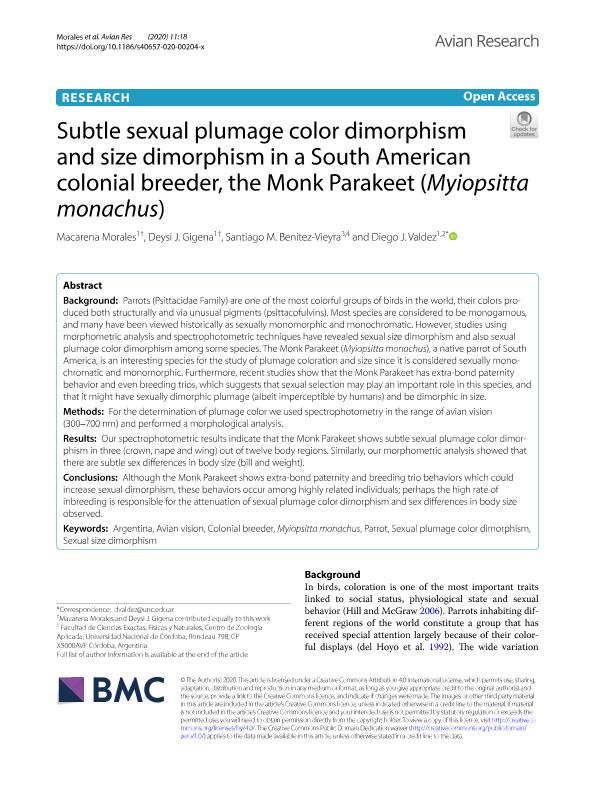Mostrar el registro sencillo del ítem
dc.contributor.author
Morales, Macarena
dc.contributor.author
Gigena, Deysi J.
dc.contributor.author
Benitez-Vieyra, Santiago Miguel

dc.contributor.author
Valdez, Diego Javier

dc.date.available
2020-10-05T20:45:25Z
dc.date.issued
2020-06
dc.identifier.citation
Morales, Macarena; Gigena, Deysi J.; Benitez-Vieyra, Santiago Miguel; Valdez, Diego Javier; Subtle sexual plumage color dimorphism and size dimorphism in a South American colonial breeder, the Monk Parakeet (Myiopsitta monachus); BioMed Central Ltd.; Avian Research; 11; 1; 6-2020
dc.identifier.uri
http://hdl.handle.net/11336/115465
dc.description.abstract
Parrots (Psittacidae Family) are one of the most colorful groups of birds in the world, their colors produced both structurally and via unusual pigments (psittacofulvins). Most species are considered to be monogamous, and many have been viewed historically as sexually monomorphic and monochromatic. However, studies using morphometric analysis and spectrophotometric techniques have revealed sexual size dimorphism and also sexual plumage color dimorphism among some species. The Monk Parakeet (Myiopsitta monachus), a native parrot of South America, is an interesting species for the study of plumage coloration and size since it is considered sexually monochromatic and monomorphic. Furthermore, recent studies show that the Monk Parakeet has extra-bond paternity behavior and even breeding trios, which suggests that sexual selection may play an important role in this species, and that it might have sexually dimorphic plumage (albeit imperceptible by humans) and be dimorphic in size. Methods: For the determination of plumage color we used spectrophotometry in the range of avian vision (300-700 nm) and performed a morphological analysis. Results: Our spectrophotometric results indicate that the Monk Parakeet shows subtle sexual plumage color dimorphism in three (crown, nape and wing) out of twelve body regions. Similarly, our morphometric analysis showed that there are subtle sex differences in body size (bill and weight). Conclusions: Although the Monk Parakeet shows extra-bond paternity and breeding trio behaviors which could increase sexual dimorphism, these behaviors occur among highly related individuals; perhaps the high rate of inbreeding is responsible for the attenuation of sexual plumage color dimorphism and sex differences in body size observed.
dc.format
application/pdf
dc.language.iso
eng
dc.publisher
BioMed Central Ltd.
dc.rights
info:eu-repo/semantics/openAccess
dc.rights.uri
https://creativecommons.org/licenses/by-nc-sa/2.5/ar/
dc.subject
ARGENTINA
dc.subject
AVIAN VISION
dc.subject
COLONIAL BREEDER
dc.subject
MYIOPSITTA MONACHUS
dc.subject
PARROT
dc.subject
SEXUAL PLUMAGE COLOR DIMORPHISM
dc.subject
SEXUAL SIZE DIMORPHISM
dc.subject.classification
Zoología, Ornitología, Entomología, Etología

dc.subject.classification
Ciencias Biológicas

dc.subject.classification
CIENCIAS NATURALES Y EXACTAS

dc.title
Subtle sexual plumage color dimorphism and size dimorphism in a South American colonial breeder, the Monk Parakeet (Myiopsitta monachus)
dc.type
info:eu-repo/semantics/article
dc.type
info:ar-repo/semantics/artículo
dc.type
info:eu-repo/semantics/publishedVersion
dc.date.updated
2020-09-21T14:47:36Z
dc.identifier.eissn
2053-7166
dc.journal.volume
11
dc.journal.number
1
dc.journal.pais
China

dc.description.fil
Fil: Morales, Macarena. Universidad Nacional de Córdoba. Facultad de Ciencias Exactas Físicas y Naturales. Centro de Zoología Aplicada; Argentina
dc.description.fil
Fil: Gigena, Deysi J.. Universidad Nacional de Córdoba. Facultad de Ciencias Exactas, Físicas y Naturales; Argentina
dc.description.fil
Fil: Benitez-Vieyra, Santiago Miguel. Consejo Nacional de Investigaciones Científicas y Técnicas. Centro Científico Tecnológico Conicet - Córdoba. Instituto Multidisciplinario de Biología Vegetal. Universidad Nacional de Córdoba. Facultad de Ciencias Exactas Físicas y Naturales. Instituto Multidisciplinario de Biología Vegetal; Argentina
dc.description.fil
Fil: Valdez, Diego Javier. Consejo Nacional de Investigaciones Científicas y Técnicas. Centro Científico Tecnológico Conicet - Córdoba. Instituto de Diversidad y Ecología Animal. Universidad Nacional de Córdoba. Facultad de Ciencias Exactas Físicas y Naturales. Instituto de Diversidad y Ecología Animal; Argentina
dc.journal.title
Avian Research
dc.relation.alternativeid
info:eu-repo/semantics/altIdentifier/url/https://avianres.biomedcentral.com/articles/10.1186/s40657-020-00204-x
dc.relation.alternativeid
info:eu-repo/semantics/altIdentifier/doi/http://dx.doi.org/10.1186/s40657-020-00204-x
Archivos asociados
